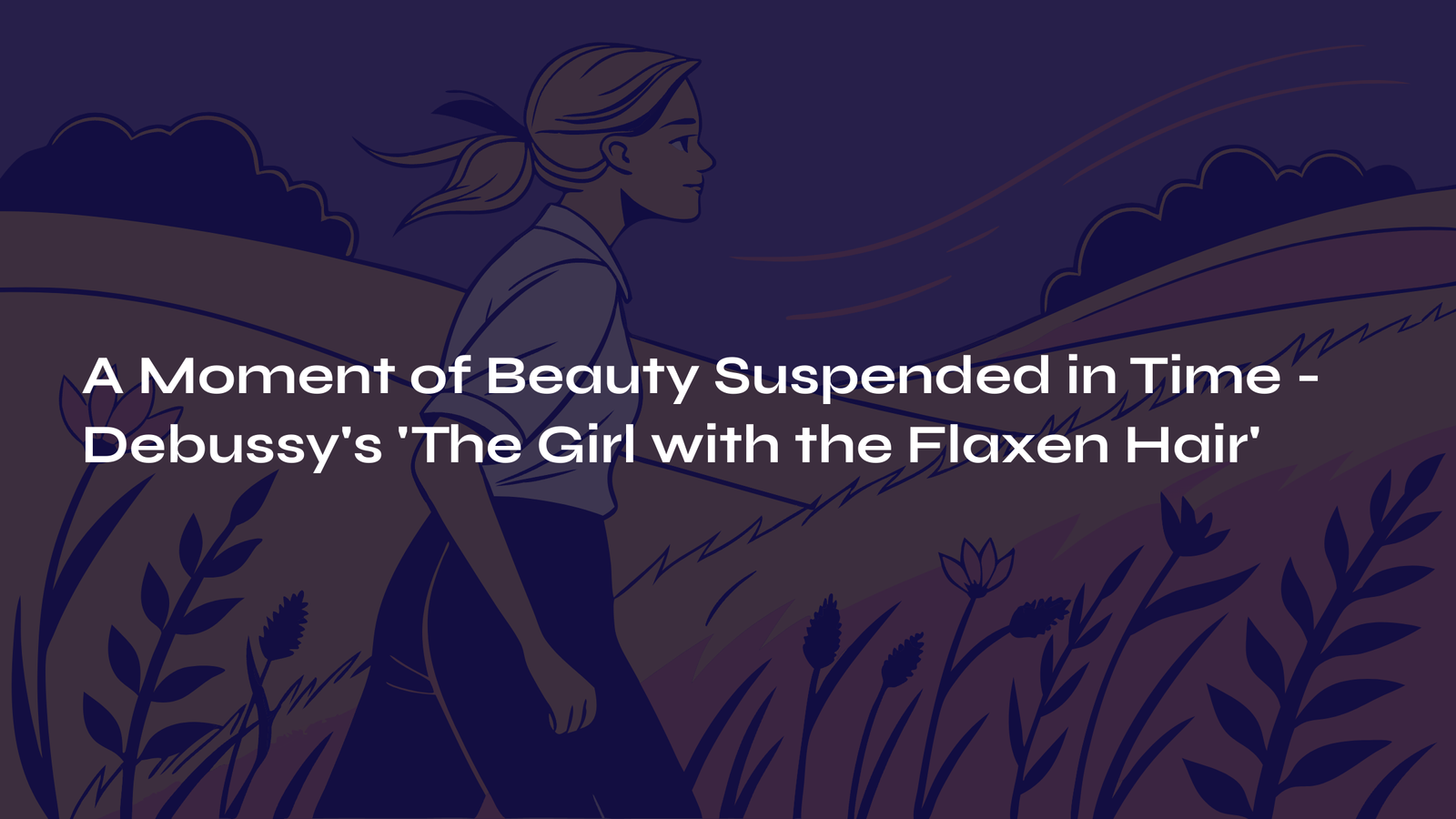Table of Contents
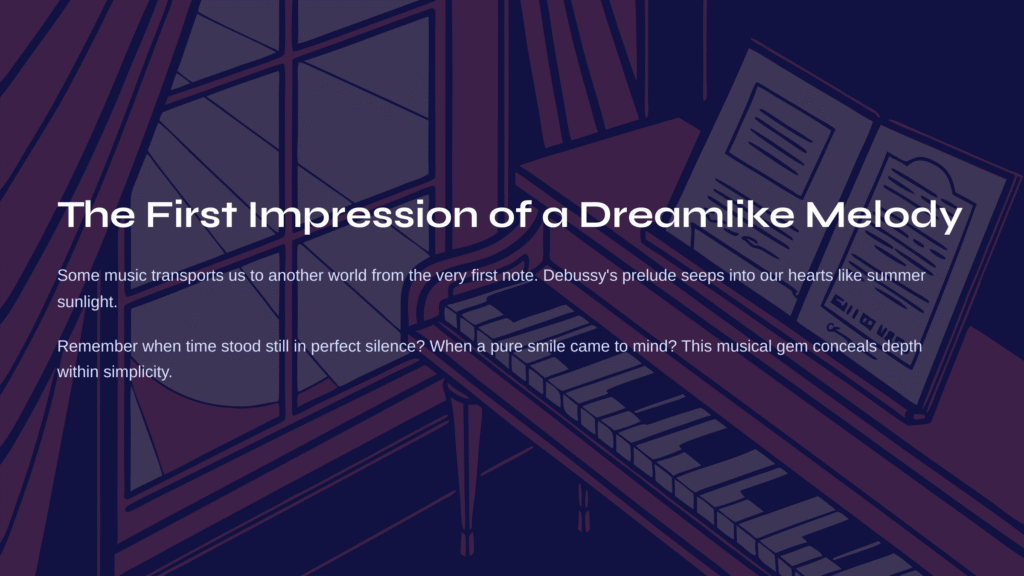
The First Impression of a Dreamlike Melody
Some music transports us to another world from the very first note. Debussy’s ‘The Girl with the Flaxen Hair (La fille aux cheveux de lin)’ is precisely such a piece. In just 2 minutes and 30 seconds, this small prelude seeps into our hearts as gently as summer afternoon sunlight.
Do you remember that feeling when you first heard the melody dancing across the piano keys? That moment when time seemed to stand still in perfect silence, and someone’s pure smile came to mind? This piece is a musical gem that conceals depth within simplicity.
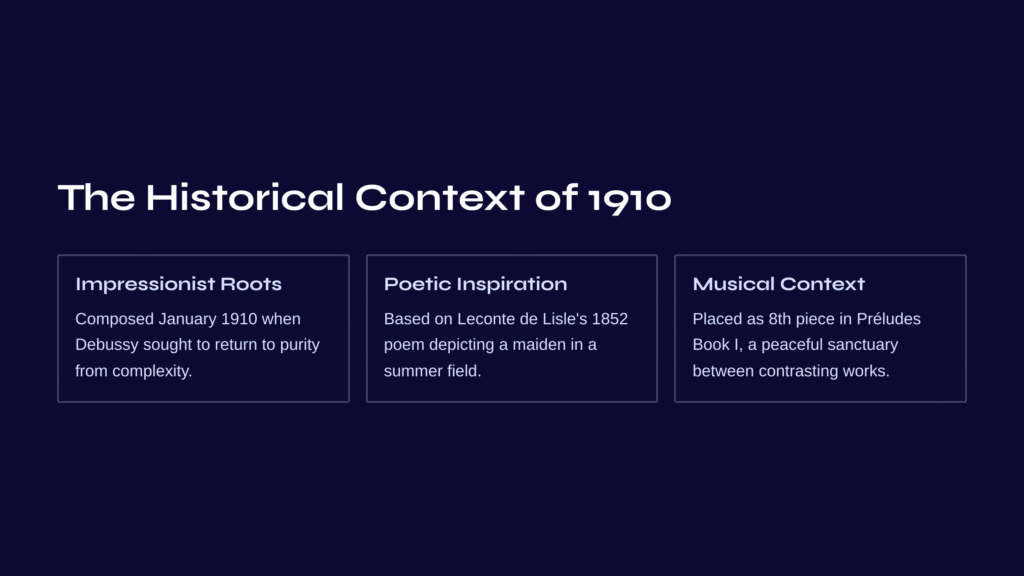
The Historical Context of 1910: When Impressionist Music Bloomed
Claude Debussy composed this beautiful prelude in January 1910. By then, he had already established himself as a master of impressionist music, but he sought to temporarily step away from his increasingly complex musical language and return to purity.
Inspired by Charles-Marie-René Leconte de Lisle’s 1852 poem from ‘Poèmes antiques,’ this piece depicts an innocent maiden playing carefree in a summer field. Instead of the chromatic and exotic harmonies he had been favoring, Debussy returned to the simple harmonies of diatonic and pentatonic scales. Just as impressionist painters captured momentary light on canvas, he painted pastoral landscapes with musical notes.
Préludes Book I consists of 12 pieces in total, with ‘The Girl with the Flaxen Hair’ placed as the 8th piece. Between the desolation of No. 6 ‘Footsteps in the Snow’ and the passionate storm of No. 7 ‘What the West Wind Saw,’ this piece serves as a peaceful sanctuary.
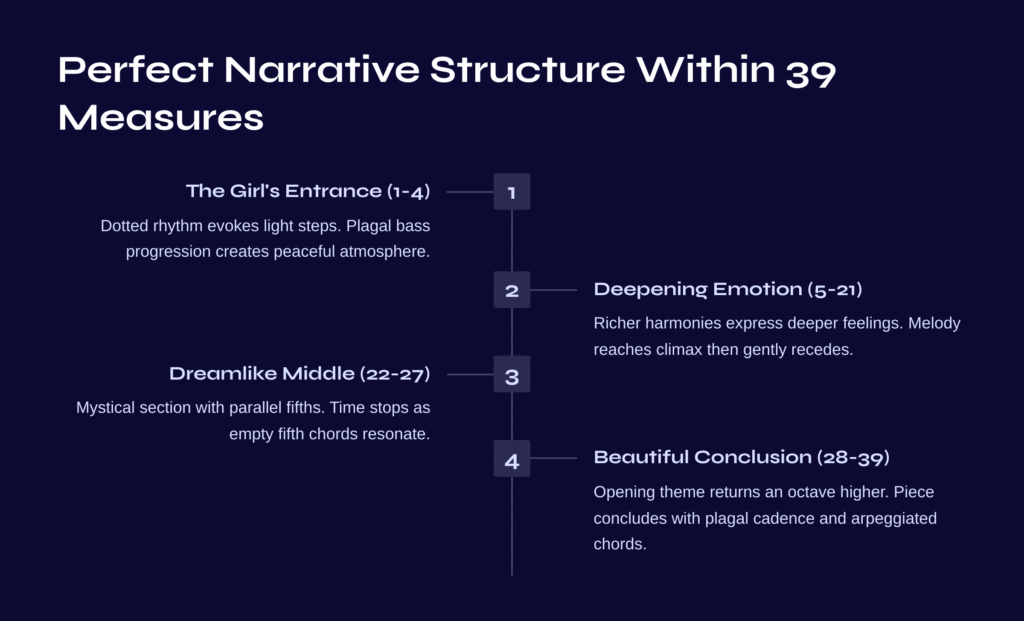
Perfect Narrative Structure Within 39 Measures
First Story: The Girl’s Entrance (measures 1-4)
The piece begins with a dotted rhythm in the right hand. The triplet-like feeling created by an eighth note and two sixteenth notes evokes the image of a girl walking across a field with light steps. The plagal bass progression in the left hand flows from subdominant to tonic in measures 2-3, creating a peaceful and reverent atmosphere like the “Amen” harmony in church music.
The melody of these first four measures possesses a purity reminiscent of Scottish folk songs. Debussy proves here that such beauty can exist without complex harmonies.
Second Story: Deepening Emotion (measures 5-21)
The same theme returns, but this time with richer harmonies in the left hand. Subtle modal colors are added, allowing the melody to express deeper emotions. It’s as if the girl has paused to lose herself in thought.
After reaching the climax marked mf at the end of measure 21, the melody descends by an octave. The beauty of this moment is difficult to express in words. It’s like an emotional wave reaching its peak and then gently receding.
Third Story: The Dreamlike Middle Section (measures 22-27)
This is the most mystical section. Parallel fifths and consecutive empty fifth chords played pianissimo resonate like a drone. Listening to this part gives one the sensation that time has stopped. It’s like the moment when the girl falls into a dream, or the sound of wind passing through a flax field.
Fourth Story: The Beautiful Conclusion (measures 28-39)
The opening theme sings for the last time, an octave higher. This time with a more transparent and clear tone, as if recalling a beautiful moment from memory. The piece concludes peacefully with a characteristic plagal leading-tone cadence and two arpeggiated octave chords (D♭ in the left hand, G♭ in the right hand).

What I Feel from This Music
Every time I listen to this brief piece, I’m reminded of some moment from childhood. I cannot say exactly what, but the pure emotions of that time wash over me like waves. Isn’t this the magic that Debussy’s music possesses? Without telling specific stories, it awakens the emotions that have been sleeping deep within each of our hearts.
Particularly in the dreamlike section of measures 22-27, I feel the flow of time changing. In that moment, as if standing at the boundary between dream and reality, music transcends mere sound to become an experience.
The comfort this piece provides is special. It has the power to temporarily escape from the complex, fast-paced daily life and help us find peace of mind. Though it’s just a short piece of 39 measures, it seems to contain all the beautiful moments of life.
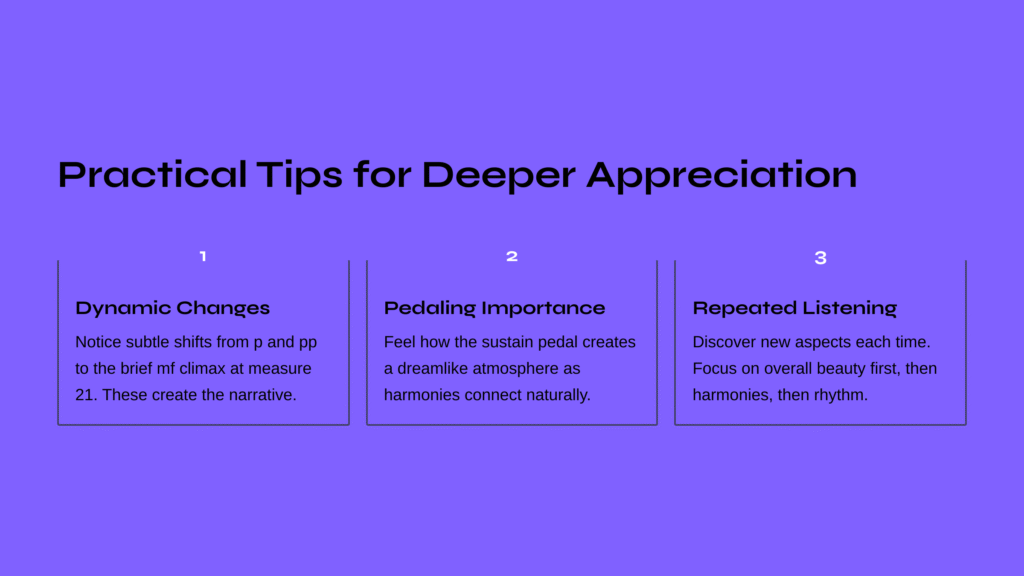
Practical Tips for Deeper Appreciation
First, pay attention to the various dynamic changes. Most of the piece is played p (piano) and pp (pianissimo), but the brief mf (mezzo-forte) climax at measure 21 provides great emotional impact. These subtle changes in dynamics create the narrative of the entire piece.
Second, feel the importance of pedaling. The use of the sustain pedal is particularly important in this piece. Don’t miss the dreamlike atmosphere created as the harmonies naturally connect. If possible, it’s good to compare and listen to versions by different performers.
Third, believe in the value of repeated listening. This piece allows you to discover new aspects each time you listen. Focus on the overall beauty the first time, the subtlety of harmonies the second time, and the exquisiteness of rhythm the third time.
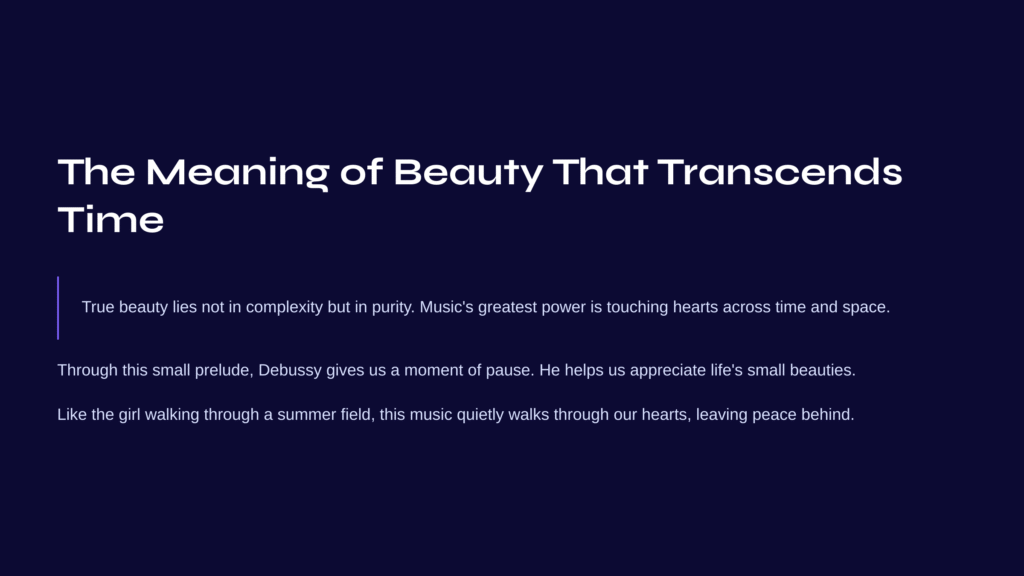
The Meaning of Beauty That Transcends Time
‘The Girl with the Flaxen Hair’ is a precious gift that Debussy left for us. Listening to this piece, I think about how true beauty lies not in complexity but in purity. And that music’s greatest power is to touch our hearts while traveling across time and space.
Through this small prelude, Debussy gives us a moment of pause. He helps us realize once again the preciousness of the small beauties we miss in our busy daily lives. Like the girl with flaxen hair walking through a summer field, this music also quietly walks through our hearts, leaving peace behind.
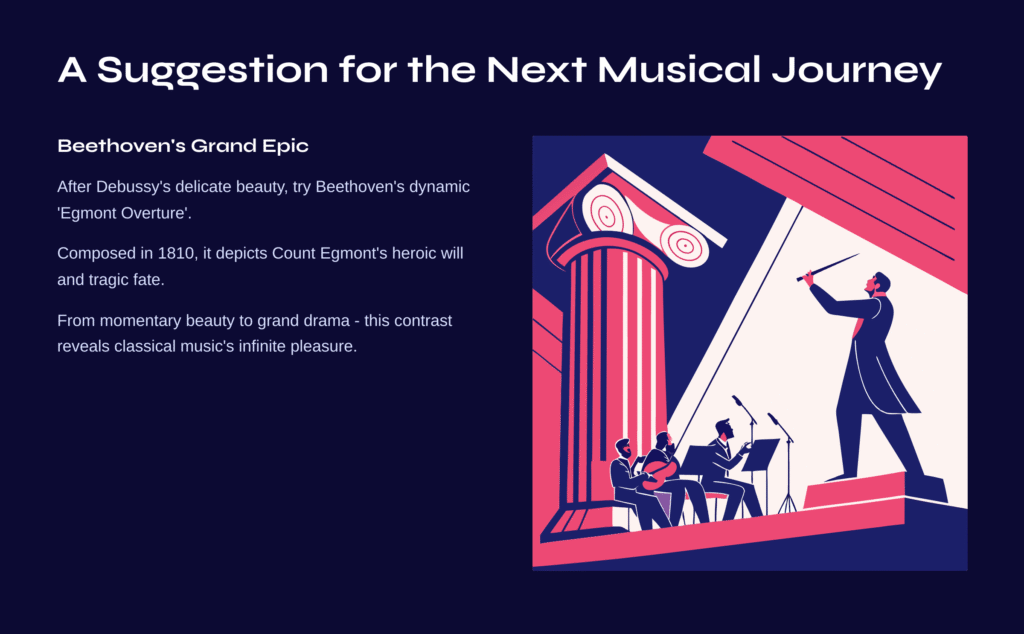
A Suggestion for the Next Musical Journey: Beethoven’s Grand Epic
Having fully savored Debussy’s delicate and impressionistic beauty, how about embarking on music of a completely different color? Beethoven’s ‘Egmont Overture’ is a dynamic and dramatic work that stands at the opposite end from Debussy’s static beauty.
Composed in 1810, this overture is part of the incidental music for Goethe’s play of the same name, depicting the tragic fate and heroic will of Count Egmont, a hero of Dutch independence. If ‘The Girl with the Flaxen Hair’ is about a girl in a quiet field, the ‘Egmont Overture’ is the story of a hero who maintains his convictions in the turbulent currents of history.
From Debussy’s momentary beauty to Beethoven’s grand drama – isn’t such a contrasting journey the infinite pleasure that classical music provides?
